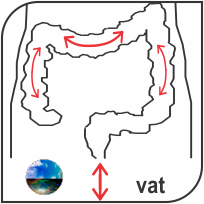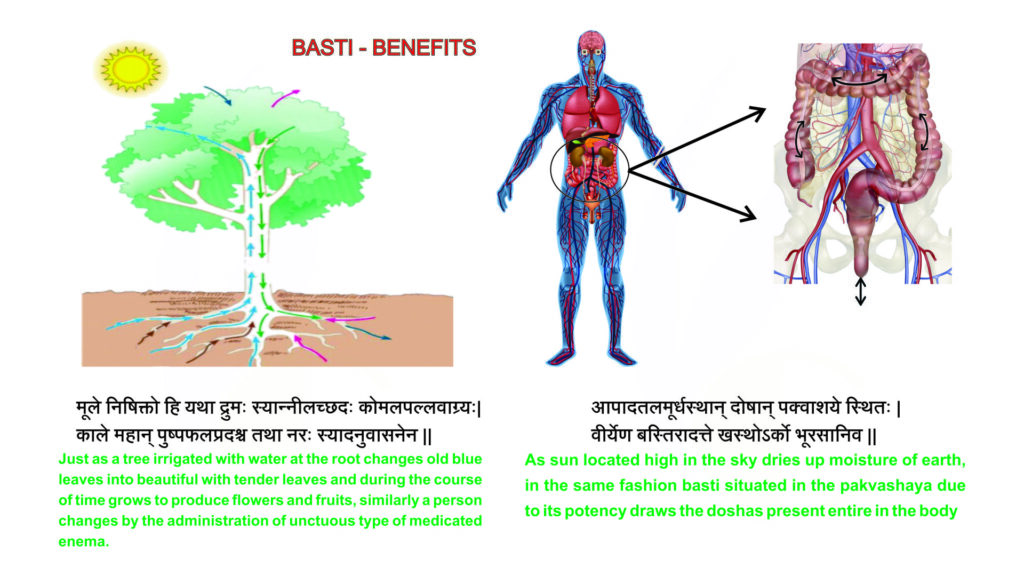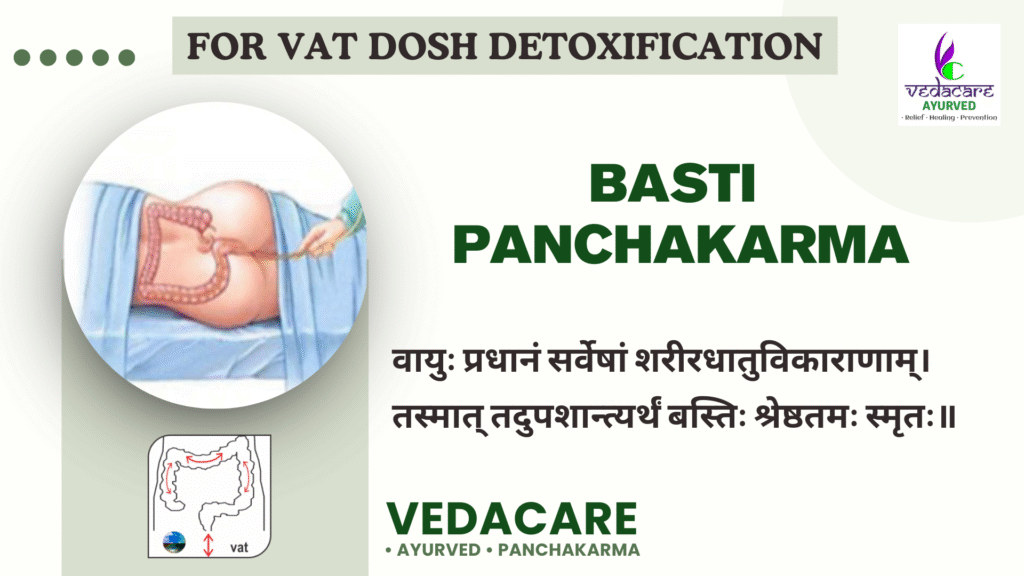PANCHAKARMA
Basti Panchakarma-बस्ती
The Pinnacle of Ayurvedic Detox

Basti Panchakarma is one of the five major detoxification – Panchakarma therapies in Ayurveda, specially designed for eliminating Vata dosha, the root cause of more than 80% of diseases. Often referred to as the “half treatment of Ayurveda” due to its widespread benefits.
Basti, derived from the Sanskrit word meaning “to hold” or “bladder,” is a specialized Panchakarma therapy that involves administering medicated oils, decoctions, or herbal preparations through the rectum using a Basti yantra (enema apparatus). As the primary treatment for Vata dosha imbalances, Basti detoxifies the colon, nourishes vital organs, and restores systemic balance.
The Charaka Samhita (Siddhi Sthana 1.27) praises Basti, stating:
बस्ती वातहरे श्रेष्ठं न च तस्यास्ति किञ्चन।
Basti is the supreme therapy for pacifying Vata, with no equal.
बस्तिर्वातहरो ह्येष सर्वरोगहरः परः।
– च.सि.१/३९Basti is the best Vata-pacifying therapy and cures all diseases.
What Is Basti Panchakarma?
Basti is an Ayurvedic enema therapy that balances Vata dosha by introducing herbal oils or decoctions into the colon. It is not merely a purgative but a rejuvenative, nourishing, and disease-curing therapy, with both eliminative (Shodhana) and palliative (Shamana) actions.
बस्ती सर्वसाधनानां प्रधानतमं आयुष्यं आरोग्यं बलं मेधां…
– च.सि.१/३९Among all the treatments, Basti is the best – it promotes longevity, health, strength, and intellect.
Unlike other Panchakarma therapies like Vaman or Virechan, Basti’s unique ability to target the colon—the seat of Vata—makes it exceptionally effective for a wide range of conditions, from digestive disorders to neurological issues. Its systemic action influences organs like the liver, kidneys, and brain, promoting holistic wellness.
Why Basti is the Most Important Panchakarma Therapy
Basti is often considered the most versatile and impactful Panchakarma therapy due to its:
- Comprehensive Vata dosh Management: Vata governs all bodily movements, including nerve impulses and digestion. Basti directly regulates Vata, addressing the root of many chronic conditions.
- Systemic Reach: Unlike Vamana or Virechana, Basti’s influence the entire body through the colon’s rich vascular network.
- Dual Action: Basti combines cleansing and nourishing with Niruha and Anuvasana Basti, making it suitable for both detoxification and rejuvenation.
- Wide Applicability: Treats conditions from arthritis to infertility, suitable for all ages when guided by an expert.
How Basti Panchakarma Works
Basti delivers medicated oil / ghee, herbal decoction, or milk-based preparations directly into the colon, where Vata resides. The colon’s mucosal lining absorbs these substances, allowing them to:
- Soften and mobilize accumulated doshas
- Cleanse Toxins: Basti flushes out accumulated toxins (ama) and morbid Vata.from the colon and tissues.
- Nourish Tissues: Basti (oil-based) lubricates and strengthens the colon, joints, and nervous system. Rejuvenate body systems through nutrient-rich herbs
- Regulate Systemic Functions: The colon’s nerve and blood supply facilitate the distribution of medicinal properties to organs like the liver, kidneys, and brain. Calm the nervous system and regulate hormones Improve Apana Vata, which governs elimination, reproduction, and vital organs functions.
Benefits of Basti Panchakarma
Basti offers a wide array of physical, mental, and systemic benefits, including:
- Pain Relief: Alleviates joint pain, backache, and sciatica.
- Improved Digestion: Enhances digestion, agni (digestive fire), reducing bloating and IBS.
- Neurological Support: Benefits conditions like paralysis, Parkinson’s, and insomnia.
- Joint Health: Relieves chronic joint and nerve pain,Reduces inflammation in arthritis and spondylosis.
- Weight Management: Supports obesity management by clearing Vata-related blockages.
- Reproductive Health: Restores hormonal and reproductive health, enhances fertility and treats menstrual disorders.
- Mental Clarity: Calms the mind and improves sleep, Reduces anxiety, stress, and depression.
- Detoxification: Clears toxins from the colon and and balances Vata.
- Nourishes tissues and boosts strength
- Prevents premature aging (anti-aging Rasayana effect)
Indications for Basti Therapy
Basti is recommended for a broad spectrum of Vata-dominant and systemic conditions, including:
Neurological & Musculoskeletal:
- Sciatica (Gridhrasi)
- Arthritis (Sandhivata, Aamavata)
- Paralysis (Pakshaghat)
- Spondylosis, backache, Lumbago, Gout
Gastrointestinal & Metabolic:
- Chronic constipation
- IBS, IBD, Ulcerative Colitis
- Abdominal bloating, gas
- Obesity, Thyroid, Diabetes
- Hyperlipidaemia
Gynecological & Reproductive:
- PCOS, irregular periods
- Prostate Problems
- Infertility (male & female)
- Endometriosis, menopause
- Sexual debility, low libido
Psychological & Systemic:
- Insomnia, Anxiety, Depression
- Memory loss, Fatigue, Burnout
- Parkinson’s Diseases, Epilepsy,
- Multiple sclerosis
- Hemiplegia, facial paralysis, chronic fatigue.
Skin Conditions:
Dry skin and eczema caused by Vata imbalance.
स्निग्धो बस्तिर्हि मर्मस्थो रोगान्गाढांश्च नाशयेत्।
– अ.हृ. सि १/६Unctuous Basti reaches deep into joints and nerves to cure chronic, deep-seated diseases.
Contraindications for Basti Therapy:
Basti should be avoided or modified in the following conditions:
- Acute diarrhea or dysentery
- Severe fever or infections
- Rectal bleeding
- Colon cancer
A thorough assessment by an Ayurvedic practitioner is essential to ensure safety.
Types of Basti Panchakarma:
| Sanskrit Name | Type | Purpose |
| Anuvasana Basti | Oil Basti | Nourishing, Vata-pacifying |
| Niruha / Asthapana Basti | Decoction Basti | Detoxifying, cleansing |
| Kshira Basti | Milk Basti | Cooling, soothing for inflammation |
| Sneha Basti | Oil/Ghee Basti | Rejuvenate, promotes fertility |
| Yapana Basti | Combination of oil & decoction | Rasayana & balancing |
| Lekhana Basti | Fat-reducing | For obesity & metabolic disorders |
| Matra | Basti Small-dose oil Basti | Used daily or during travel |
| Rajayapana Basti | Rejuvenative for kings | Promotes longevity, virility, and strength |
Basti is administered in various forms, tailored (What are the types of Basti in Ayurveda?). Common types include:
- Niruha Basti (Decoction):
- Uses herbal decoctions mixed with honey, salt, and oils.
- Cleanses toxins and morbid Vata.
- Retained for 15–30 minutes.
- Anuvasan Basti (Oil):
- Uses medicated oils or ghee.
- Nourishes tissues and lubricates the colon.
- Retained for 1–8 hours.
- Uttar Basti:
- Administered through the urethra or vagina for reproductive and urinary disorders.
- Highly specialized, performed by experts.
- Matra Basti:
- A low-dose oil enema for daily use in chronic Vata conditions.
- Safe for long-term administration.
Basti Courses:
Basti is typically administered in structured courses:
- Karma Basti: 30 days (18 Niruha + 12 Anuvasana) for severe conditions.
- Kala Basti: 16 days (10 Niruha + 6 Anuvasana) for moderate issues.
- Yoga Basti: 8 days (5 Niruha + 3 Anuvasana) for mild imbalances.
| Basti name | Basti duration | Niruha Basti | Anuvasana Basti |
| Karma Basti | 30 days | 18 | 12 |
| Kala Basti | 16 days | 10 | 6 |
| Yoga Basti | 8 days | 5 | 3 |
Basti Panchakarma Procedure:
Basti follows a structured protocol to ensure efficacy and safety, divided into three stages:
1. Purvakarma (Pre-Procedure Preparation)
- Patient Assessment: The practitioner evaluates the patient’s dosha, strength, and suitability, ruling out contraindications.
- Dipana-Pachana: Digestive medicines are given for 1–2 weeks to optimize agni and clear ama.
2. Pradhana Karma (Main Procedure)
- The procedure is painless, performed with the patient lying on their left side to optimize colon access. The lukewarm oil or decoction is slowly administered via Basti yantra or using sterile enema nozzle.
- The medicated solution is retained for a specific duration (e.g., 15–30 minutes for Niruha or longer for Anuvasana), ensuring maximum absorption.
3. Paschat Karma (Post-Procedure Care)
- A light, Vata-pacifying diet is followed to restore digestion.
- Patients avoid cold exposure, heavy exercise, and stress.
- Light food is given after elimination.
- Monitor bowel movements and provide rest.
Basti Diet: Pre- and Post-Therapy Guidelines
Diet is critical for Basti’s success, supporting detoxification and recovery.
Pre-Basti Diet
- Before Basti: Light meals like vegetable soup or khichdi to prepare the colon. Warm, unctuous, easily digestible meals, like rice, lentil soup, Moong dal khichdi and ghee. Avoid Vata-aggravating foods (e.g., raw salads, beans).
- Avoid: Cold, raw, spicy, fermented food
Post-Basti Diet
The post-therapy diet varies by course duration:
वातानुलोमनो बस्तिः… आयुः स्मृतिबलं मेधां वर्णं स्वरमुपैति च।
– च. सि.१/२५Basti regulates Vata, enhances life span, memory, strength, intelligence, complexion, and voice.
Basti’s Mechanism
Basti’s therapeutic action is supported by its:
- Colon Targeting: The colon’s nerve plexus and blood vessels distribute medicinal properties systemically.
- Vata Regulation: Balances nerve impulses, digestion, and elimination.
- Anti-Inflammatory Effects: Reduces joint and tissue inflammation.
- Modern Validation: Studies suggest Basti’s role in managing IBS, arthritis, and neurological disorders by modulating gut-brain axis and inflammation.
Why Is Basti Panchakarma Important?
Unlike other Panchakarma procedures like Vamana (emesis) and Virechana (purgation) which target Kapha and Pitta respectively, Basti is the only Panchakarma treatment that effectively balances Vata, the most subtle and powerful dosha responsible for all movements in the body.
Importance Over Other Panchakarmas:
- Direct action on colon, the main seat of Vata
- Deep tissue detox and nourishment
- Applicable in both acute and chronic conditions
- Suitable for all age groups, including elderly and children
- Enhances absorption, elimination, and regeneration

1. What is Basti Panchakarma?
Basti is one of the five Panchakarma treatments in Ayurveda. It involves the administration of medicated oils, decoctions, or ghee through the rectal route to cleanse the colon, balance Vata dosha, and promote overall health.
2. Who can benefit from Basti therapy?
Basti is effective for arthritis, constipation, sciatica, neurological disorders, IBS, infertility, skin problems, lower back pain, and vata-related disorders. It is also used for anti-aging and detoxification.
3. How long does Basti treatment take?
Courses range from 8–30 days
4. How does Basti help with joint pain?
Basti reduces Vata-related inflammation and lubricates joints, alleviating pain in conditions like arthritis and sciatica
5. Is Basti safe for everyone?
Yes, Basti is a safe and gentle detox therapy suitable for children, elderly, and even weakened individuals when administered under professional Ayurvedic guidance.
6. Is Basti Painful?
No, when done correctly, it’s comfortable & relaxing.
7. Does Basti Cause Weakness?
Mild fatigue may occur, but diet restores energy.
8. Can Basti help with constipation and gas?
Absolutely. Basti directly targets the colon and is one of the best Ayurvedic treatments for chronic constipation, bloating, and flatulence, especially when Vata is aggravated.
9. Can Basti improve mental health?
Yes, Basti reduces Vata-related anxiety, insomnia, and stress by calming the nervous system.
10. How often should Basti be done?
Basti is performed as needed or seasonally, based on dosha imbalances and practitioner guidance.
11. What foods should I avoid during Basti?
Avoid Vata-aggravating foods like raw salads, beans, and cold drinks. Stick to warm, cooked meals.
12. When is the best season for Basti?
Basti can be done any time of year after checkup in health problems but, Varsha Ritu (Monsoon) is ideal, as Vata naturally aggravates during this time. Seasonal Basti helps prevent chronic diseases.
13. Can Diabetics Take Basti?
Yes, it helps in diabetic patient
14. Can Basti treat infertility?
By balancing Vata and detoxifying the reproductive system, Basti improves uterine health, semen quality, ovulation, and overall hormonal balance—thereby boosting natural fertility
15. Can Basti help in weight loss?
Yes. Lekhana Basti is specially formulated to reduce fat, correct metabolism, and help manage obesity and related hormonal imbalances.
16. How many days does Basti treatment take?
Yoga Basti: 8 days
Kala Basti: 16 days
Karma Basti: 30 days
The duration depends on the patient’s condition and health goals.
17. Does Basti cause any side effects?
When done correctly under Ayurvedic supervision, Basti has no side effects. It gently detoxifies without disturbing digestion or nutrient absorption, unlike modern laxatives.
18. What should I eat after Basti therapy?
Post-Basti, a light Ayurvedic diet is recommended:
Warm water
Moong dal soup (yusha)
Rice gruel (kanji)
Meat soup (mamsa rasa)
Avoid cold foods, fried items, and untimely eating.
Basti Panchakarma is a transformative Ayurvedic therapy that balances Vata, detoxifies the body, and addresses a wide range of conditions, from arthritis to neurological disorders. Its structured preparation, administration, and post-therapy care ensure safety and efficacy, making it the most versatile Panchakarma therapy. By integrating Basti into your wellness routine under expert guidance, you can achieve lasting health, vitality, and balance. Consult a qualified Ayurvedic practitioner to explore Basti’s benefits for your unique needs.
To enhance and fastening the disease healing, Basti therapy is often combined with Raktamokshan, Vaman, Virechana, Shirodhara, Lepan treatments



